Introduction
The women in our lives make several sacrifices for us, including sacrificing their bodies. For several years I have been a supporter of women getting pre-pregnancy, during pregnancy, and postpartum physical therapy. The reason being is the toll bringing a child into this world takes on women’s bodies. I am aware that this topic is usually covered by women partly because women can speak from experience and partly because the patients might be more comfortable talking about topics of this nature with another women.
I don’t want this post to seem like a man trying to place women into a mold of expected appearance. I have no desire to change how women look, especially postpartum. This post is only about helping those mothers that have sacrificed their bodies for their children and; lets be honest, their men. This is for mothers who feel they have lost a piece of themselves since becoming mothers and would like to take it back. This is about focusing on the common conditions that postpartum women are talking about in their groups of friends because they’re all experiencing similar conditions. My only goal with this post is to improve women’s functional ability, strength, and self-esteem for the self-less act of mothers who sacrifice so much.
Motivation for This Post
My motivation for this post comes primarily from my beautiful wife and partly from her friends asking me to create some “mommy workouts” for them. I don’t want to change anything about my wife’s appearance. I do however, want to help fix the physical and emotional pains associated with her pregnancies and being a mother. Altogether we have eight children. My wife carried our five youngest, all of which were prior to me becoming a physical therapist. Had my kids been born after PT school, I would’ve known which exercises to prescribe to my wife to make her pregnancies more comfortable and her recoveries easier and shorter. I believe it is accurate to say my wife and most women have not fully recovered from their first pregnancy even if that was over ten years ago.
Each of my wife’s five deliveries were delivered through cesarean section (C-section). This is done by making an incision horizontally (in most cases) across and completely through the lower abdomen muscles. Think about what type of impact this would have on any muscle. Anytime you cut a muscle it takes deliberate action to make it functional and strong again. Aside from C-sections; as with any pregnancy, her body went through other changes as well. These changes were due to her pregnancies however, they were not resolved with delivery. Wanting to help my wife, her friends, and any other women that may have these conditions, I realized it was time to go beyond being a supporter of postpartum PT and start being a promoter and provider of postpartum PT.
Why are postpartum exercises important?
Think about any major surgery or procedure. Doctors typically send their patients to physical therapy afterward, right? Why aren’t postpartum women being sent to PT? Especially those that have had a C-section. I can’t speak for anyone else, but I would consider pushing another human from your body or being cut open to remove another human from your body a major procedure. Even with a “perfect pregnancy” and “perfect vaginal delivery”; I would say both are at least rare, if not impossible, a woman’s body goes through some drastic changes.
Let’s look at some of these changes that women experience during pregnancy and postpartum. Headaches, poor posture due to tight pectoralis muscles and weakened back muscles, weakened triceps, biceps tightness, sagging breasts, lower back pain, likely due to stretched and weakened abdominal muscles, hip pain, SI joint pain, sciatica, feet pain/bigger feet, leaking urine, and depression.
I wasn’t surprised by any one problem on this list because I have seen each of them associated with pregnancy at least once before however, once they are all listed out together, the number of problems is surprising. In case you didn’t count, that was fourteen different conditions. Why is a list like that left untreated? I’m not implying that every woman that has had a child has each of these conditions however, it would be hard to believe that the majority of mothers have not experienced or are not currently experiencing multiple conditions on this list.
It is important to treat these conditions with physical therapy because although some conditions resolve after delivery, most of them do not just go away or get better and most people don’t have the knowledge to appropriately address these conditions on their own. By resolving these conditions mothers are stronger, can more easily complete the many daily tasks that they have, they have less pain and discomfort, they are more functional, and they have better self-esteem.
the Best exercises for pregnant and postpartum women?
These exercises are simple exercises that most everyone can do with minimal equipment and can be modified as needed. This post could be a book if I went over exercises for each of the conditions mentioned. Therefore, I will briefly go over the five of the most important exercises that every mother should do to improve the most common conditions.
Headaches/Posture
Posture can be a major contributor to headaches. Forward head and rounded shoulders posture is a common position for postpartum women because as they nurse/hold and look down at their beautiful babies. This causes their heads to come forward and their shoulders to round forward. Within the first few months of postpartum, mothers can easily spend 10-12 hours or longer each day holding and nursing their babies. Spending months in this position shortens the pectoralis and upper trapezius muscles and lengthens/weakens the deep neck flexors and muscles of the upper back. Another contributor to this position is fatigue. Posture is the last thing on their mind, and I’m not brave enough to try to correct the posture of an exhausted mother with a newborn.
This posture also causes headaches due to the muscles shortening in the back of the head and neck. Tension and stress also contribute to headaches. I think it is common knowledge that mothers of newborns are stressed and have increased tension. Again, sleep deprivation doesn’t help the situation. To reverse this position, you must do the opposite motions. Stretch the pecs and back of the neck and strengthen the front of the neck and upper back.
Cervical Retraction (Chin Tucks)
This exercise will help relieve headaches, neck pain, and help correct poor posture. The yeses and noes stretches are helpful in relieving headaches and correcting posture however, I’m not going to talk about that in detail in this post. You can check out my other post about posture to learn about that stretch. In this post I will focus on cervical retraction to focus on improving headaches and posture.
Beginners
- Lie on your back with your head resting on a small pillow. Using the muscles in your neck gently push your head back into the surface while you slightly bring your chin toward your chest without lifting your head.
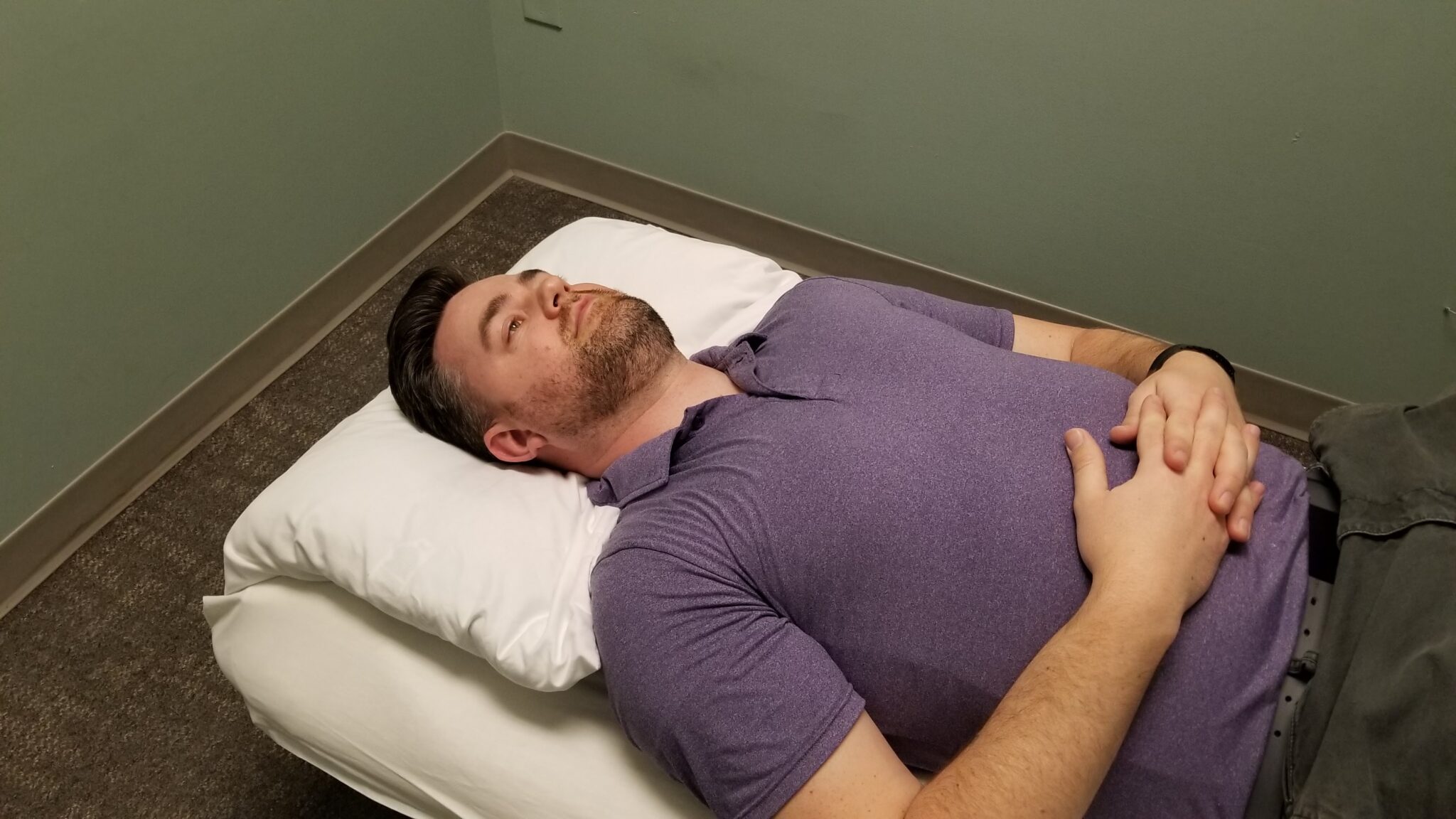
Chin Tuck Starting
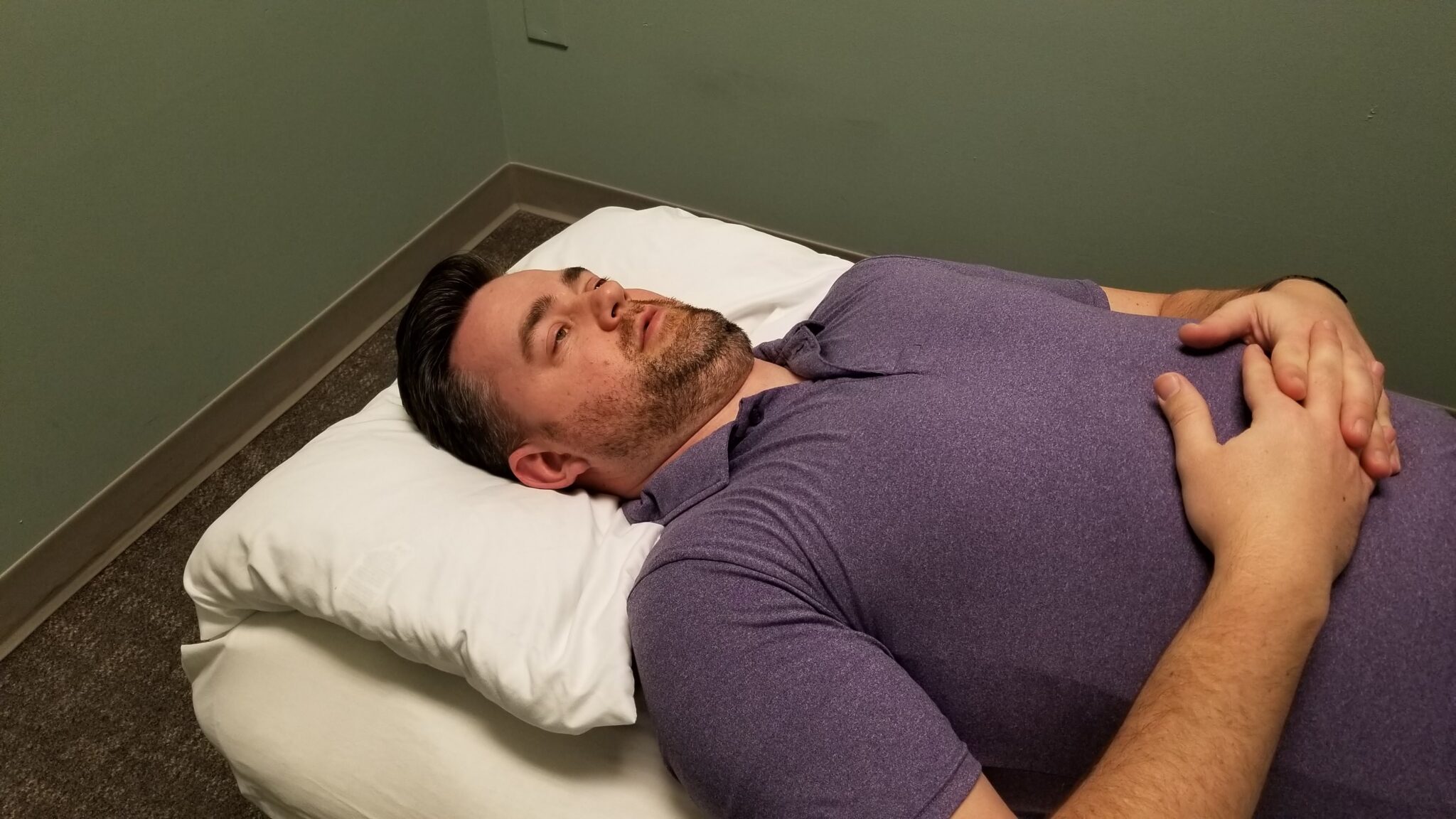
Chin Tuck Ending
Progression
- Sit upright with your shoulders down and back. Using the muscles in your neck gently pull your head back while you slightly bring your chin toward your chest without bending your neck.

Sitting Chin Tuck Starting

Seated Chin Tuck Ending
Advanced
- Lie on your stomach with your face down. Bring your shoulders back; without shrugging, as if you were sticking your chest out. Using the muscles in your neck gently lift your head while you slightly bring your chin toward your chest without bending your neck.
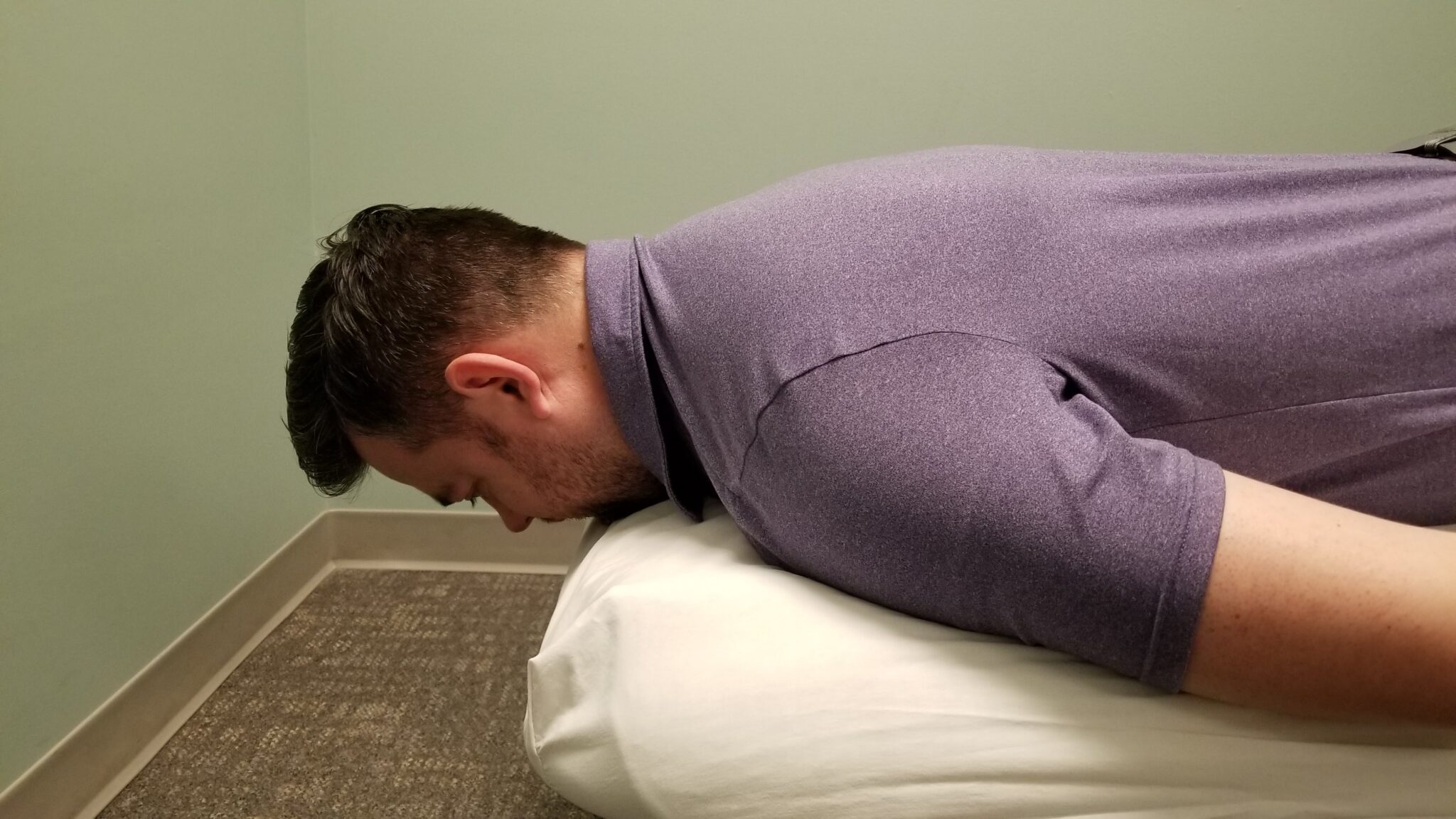
Prone Chin Tuck Starting
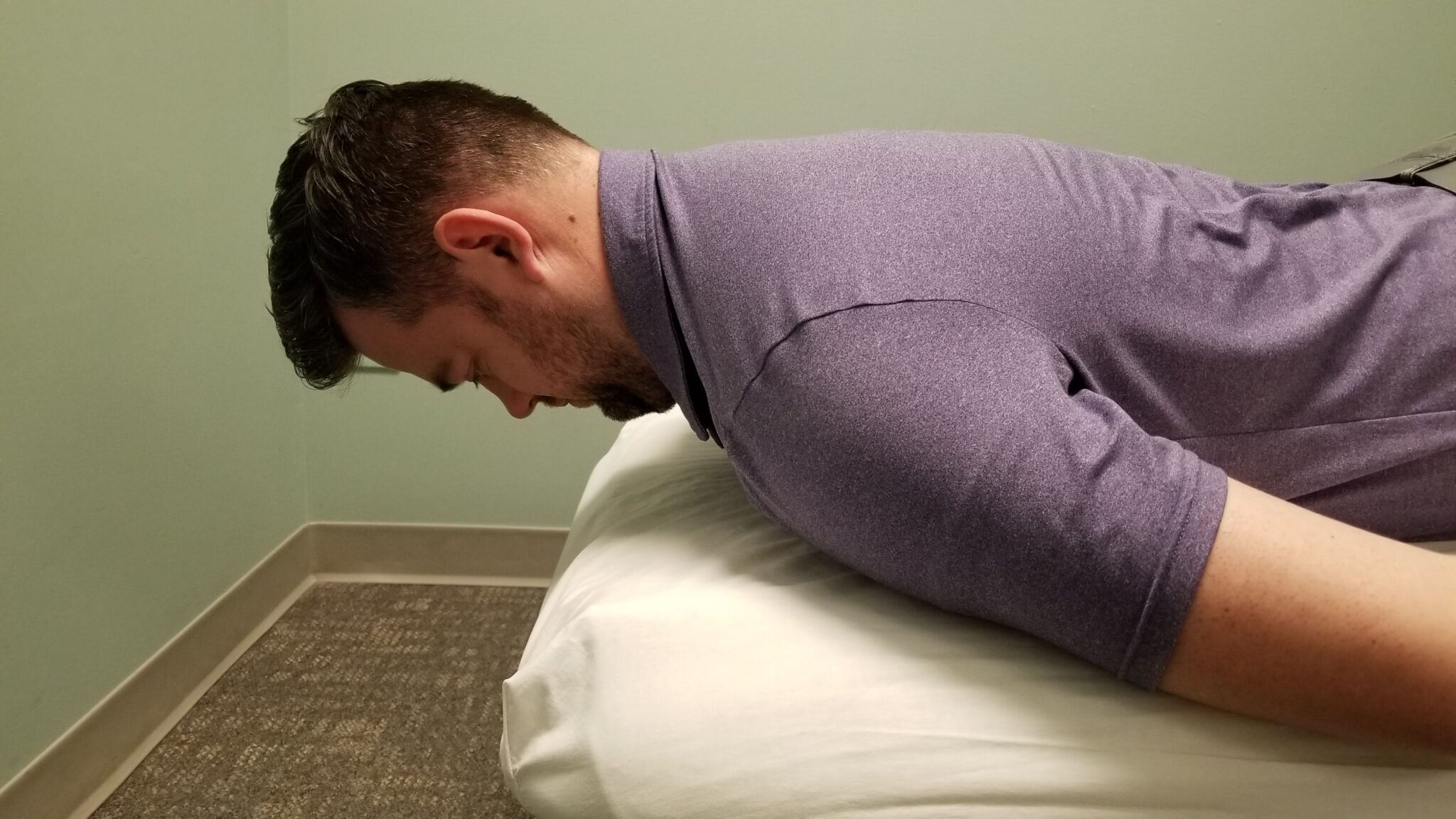
Prone Chin Tuck Ending
Exercise Frequency
The retracted position should be held for about three (3) seconds and repeated ten (10) times. This exercise should be done at least once per day, three (3) days per week however, it can be done multiple times throughout the day, every day, especially when a headache is present.
Scapular squeeze with chin tuck
The focus of this exercise is to strengthen the muscles in your upper back to improve posture and decrease upper back and neck pain. This exercise will help improve rounded shoulders. The pec stretch is another great stretch to help improve rounded shoulders. You can learn how to do this stretch in my post about posture as well.
Sit or stand with your head and shoulders in a neutral position, not rounded forward and not too far back. From this position do a chin tuck and without shrugging, bring your shoulders back and squeeze your shoulder blades (scapulae) together. Your upper trapezius can be felt at the base of your neck and top of your shoulder. This muscle should be relaxed when doing this exercise.
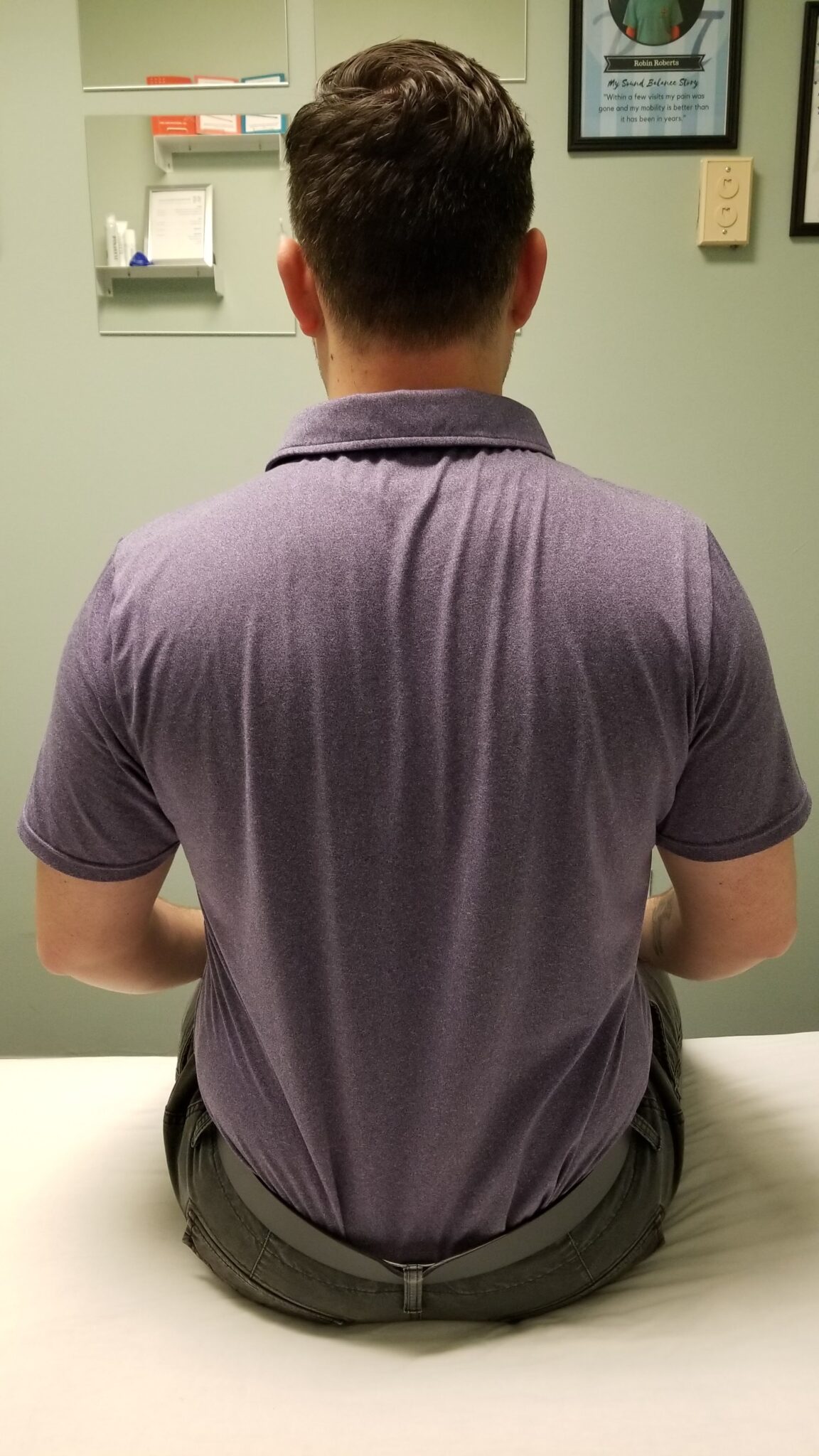
Scapular Squeeze Starting
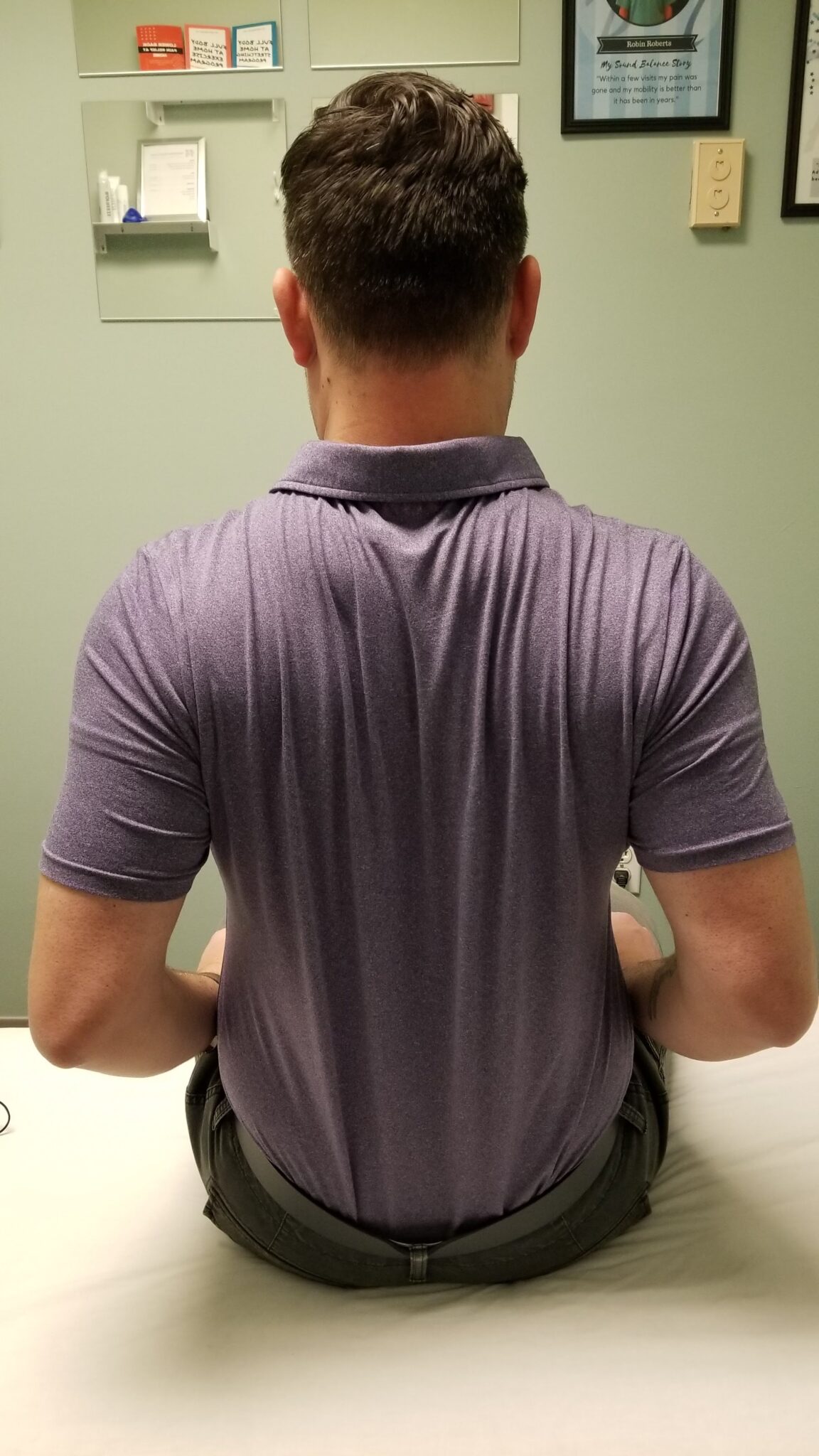
Scapular Squeeze Ending
Exercise Frequency
This position should be held for about 30 seconds and repeated three (3) times. This exercise should be done at least once per day, three (3) days per week however, it can be done multiple times throughout the day, every day for faster strengthening. This is a great exercise to do when you’re at a stop light or during commercials.
Lower back pain
There are many potential reasons for lower back pain however, with women that are or have been pregnant, this pain is commonly caused by an increased curvature of the low back. There is naturally a light curve in your lumbar spine referred to as lordosis. As women progress through their pregnancies and their babies get larger, their abdominal muscles stretch and pelvis tilts forward, both factors cause increased lordosis of the lumbar spine which contributes to lower back pain.
The stretching weakens the abdominal muscles making it difficult to tilt the pelvis back to decrease the lordosis, even after pregnancy. Also, it is common for this stretching to cause diastasis recti, which is a midline vertical separation of the abdominal muscles. If this separation is more than two finger widths (2 cm) apart you should avoid exercises and movements that cause the abdominal muscles to push out, such as sit-ups. Whether you have diastasis recti or not, one of the first exercises you should do to strengthen your core and decrease lower back pain is posterior pelvic tilts.
Posterior Pelvic tilts
Pelvic tilts are an isometric contraction exercise. These exercises hold a muscle contraction for a set amount of time without joint movement. This exercise will help relieve lower back pain by strengthening your core which decreases lumbar lordosis and provides trunk stabilizing support. To help you understand this exercise better, I want you to think about your pelvis as a bowl. Typically, after pregnancy your pelvis (the bowl) is tilted forward like something is being poured from the bowl. We want to tip the bowl back, to stop the pouring.
Lie on your back with your knees bent and your feet flat. Tighten your core as if you were trying to bring your belly button toward your spine. This activates your transverse abdominus (TA) which acts as a girdle to hold everything in and provides support to your trunk and spine. As you do this slightly tilt your pelvis as if you were trying to look at your belt buckle. You should be able to activate your TA without holding your breath. To further help with diastasis recti, use your hands or a sheet wrapped around your abdomen to bring your muscles closer together during contraction.
There are two methods to check yourself to ensure you’re doing this exercise correctly. The first is to find the top of your hips with your, then move you’re in an inch or two so you’re no longer touching bone. It should feel soft. With your thumbs in this position, activate your TA. You should feel the muscle become firm under your thumbs. You can also put your hand under the small of your back as your lying down. You are doing it correctly if you are able to put pressure on your hand with the small of your back.
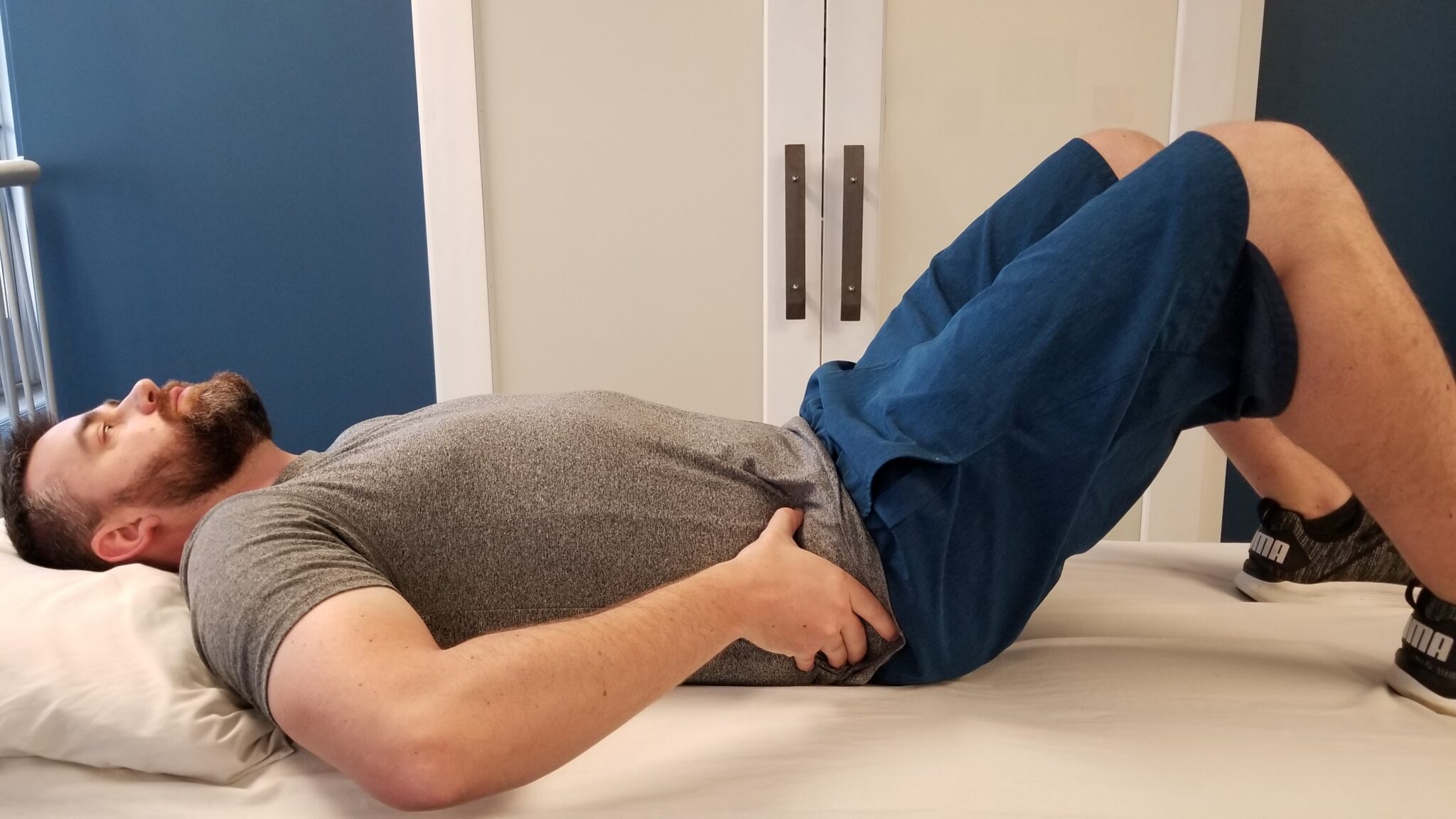
Use thumbs to feel TA activation
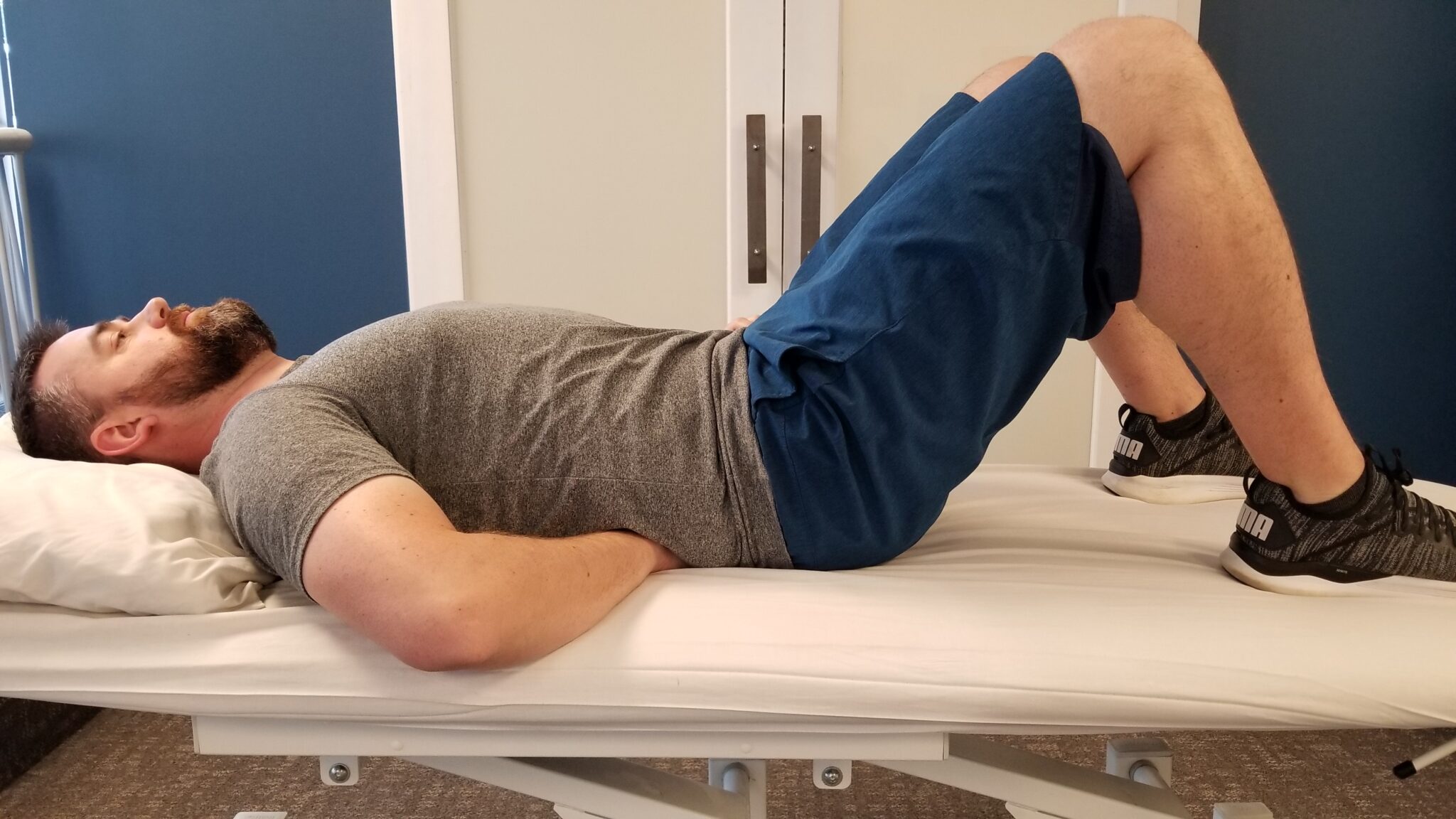
Apply pressure to hand with small of back
Exercise Progressions
This exercise can be progressed by adding marching, bridging while holding the pelvic tilt, or bridge while holding the pelvic tilt and marching. Once these progressions are mastered and if diastasis recti is less than 2 finger widths, planks are a great way to continue strengthen your abdominal muscles and decrease lower back pain.
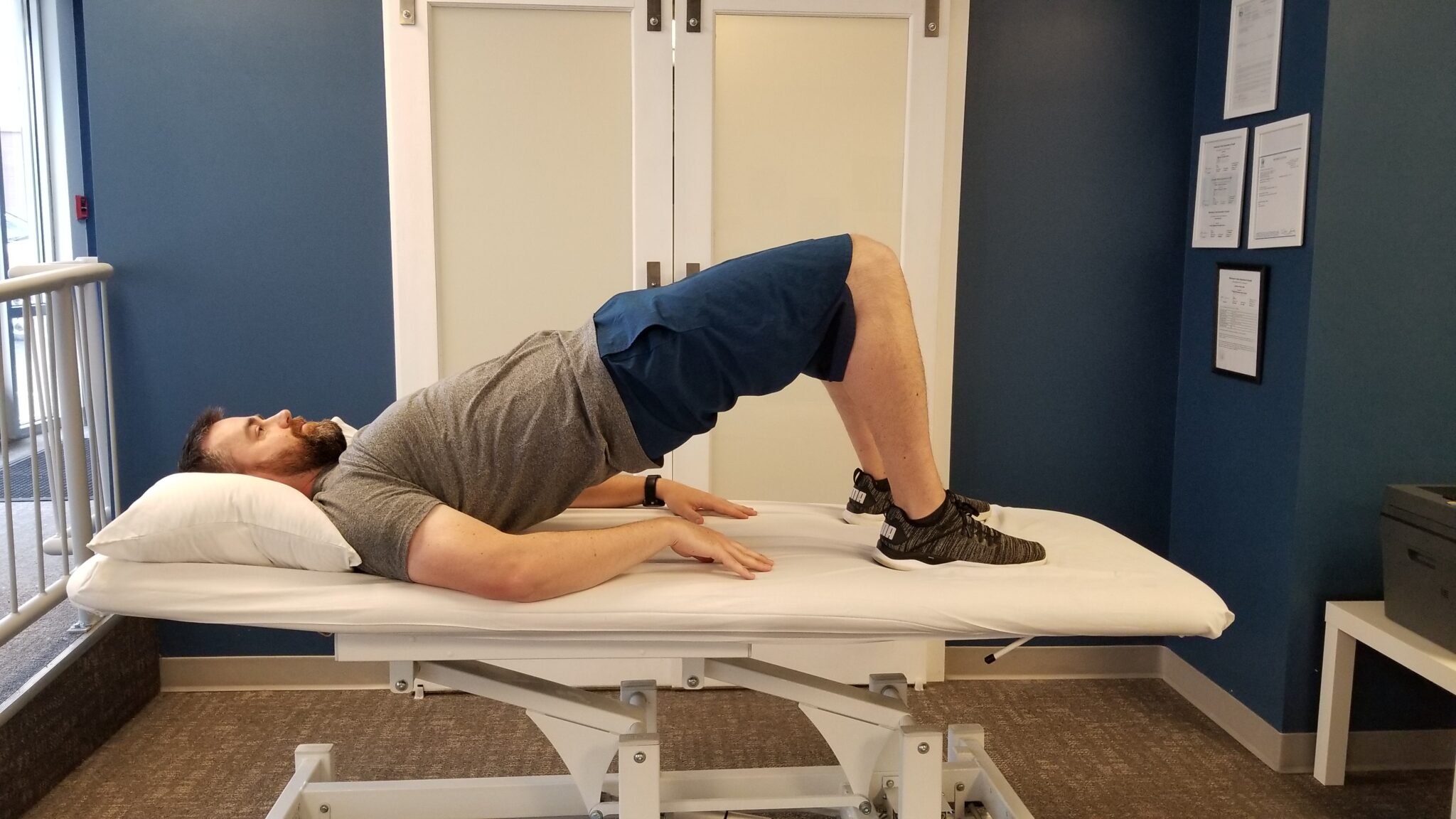
Pelvic Tilt With Bridge
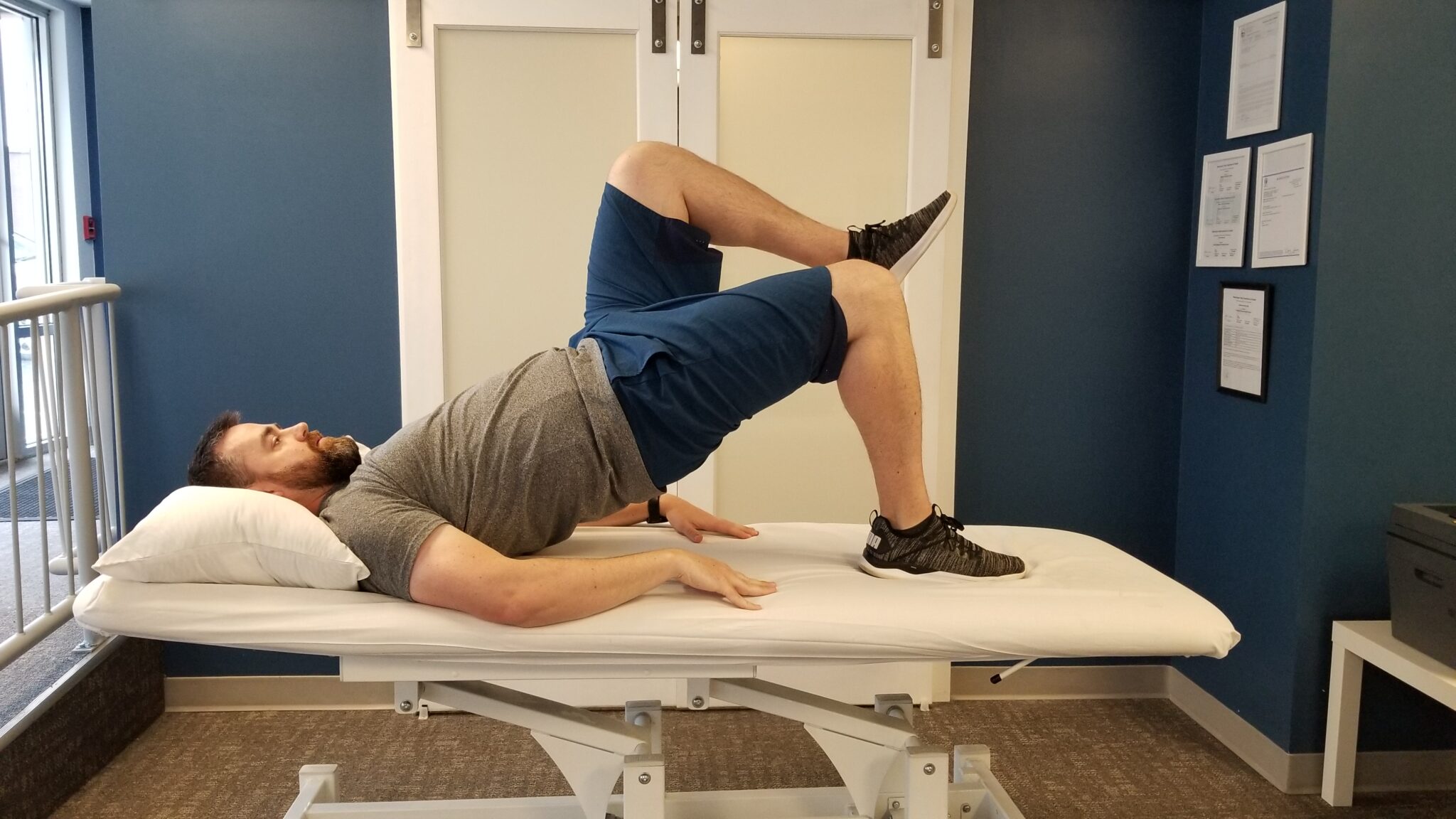
Pelvic Tilt With Bridge & Marching
Exercise Frequency
The pelvic tilt should be held for about 30 seconds and repeated three (3) times. This exercise should be done at least once per day, three (3) days per week however, it can be done multiple times throughout the day, every day for faster strengthening. This is also a great exercise to do when you’re at a stop light or during commercials as it can be done while sitting down or standing as well.
Sacroiliac Pain and Sciatica
It is not uncommon for woman that are pregnant to have sacroiliac (SI) pain or sciatica. These conditions are usually more of a problem while pregnant due to spreading of the mother’s hips as well as decreased space from a growing baby causing pressure to be applied to the sciatic nerve. Both conditions typically improve postpartum however, they can continue to be problematic for some women.
Piriformis Stretch
This stretch can be helpful in relieving SI pain because the piriformis is attached to the sacrum and the femur. As the baby grows and your hips spread, more tension is put on the piriformis. The pain can be associated with the tightness of the lengthened muscle itself or it can be associated with the tightness of the muscle preventing the SI joint from moving appropriately. The SI joint does not move much however, the restriction can cause significant discomfort. The tightness of the piriformis can also contribute to sciatica because the sciatic nerve runs right next to, or sometimes, through the piriformis muscle. As on the piriformis increases, so does the amount of pressure on the sciatic nerve. Doing this stretch will decrease tension and increase length of the piriformis which in turn will decrease pressure on the sciatic nerve as well as decrease resistance on the SI joint.
There are many ways to do this stretch. Some people cross one leg onto the other then hug their leg that is down. This is sometimes called the figure four stretch. Some people get on the ground with one leg crossed in front of them and the other leg going straight back. I’m going to teach you how I prefer and if it doesn’t work, you can search for a version that works better.
This stretch is done the same way whether you are lying down on your back or sitting in a chair. Your right ankle is placed on your left knee. From here, grab your right knee with both hands and pull your knee toward your right shoulder. You may have to try different angles to give you the best stretch by bringing your knee closer or further from your right shoulder. You can also place your left hand on your left ankle and pull your ankle up while pulling your knee across. If you are sitting, you may also lean forward as you pull your knee back to increase the amount of stretch. This stretch should be felt in the middle of the buttock, around the area of the back pocket. Complete this stretch on both sides.
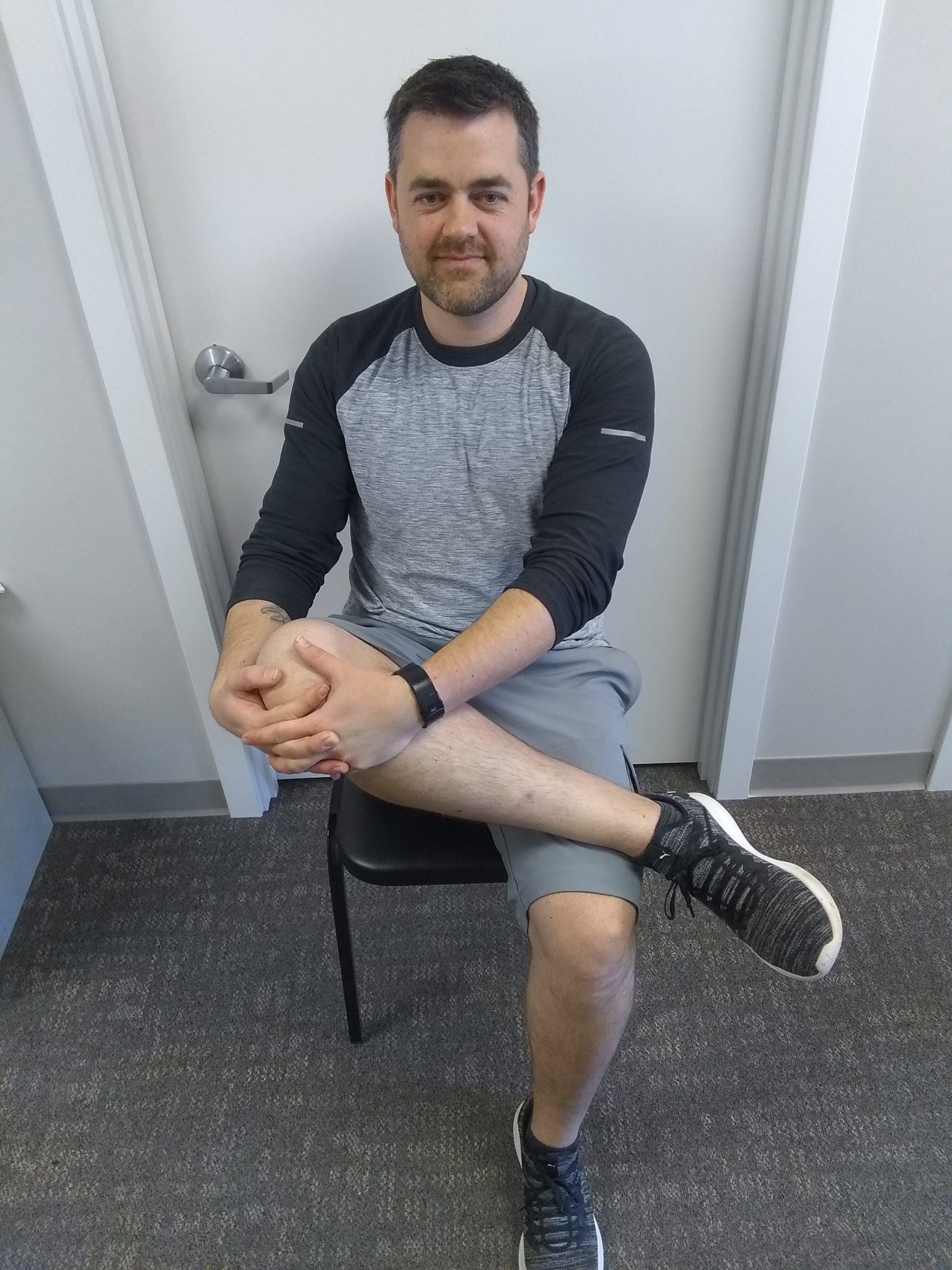
Starting Position for Piriformis Stretch
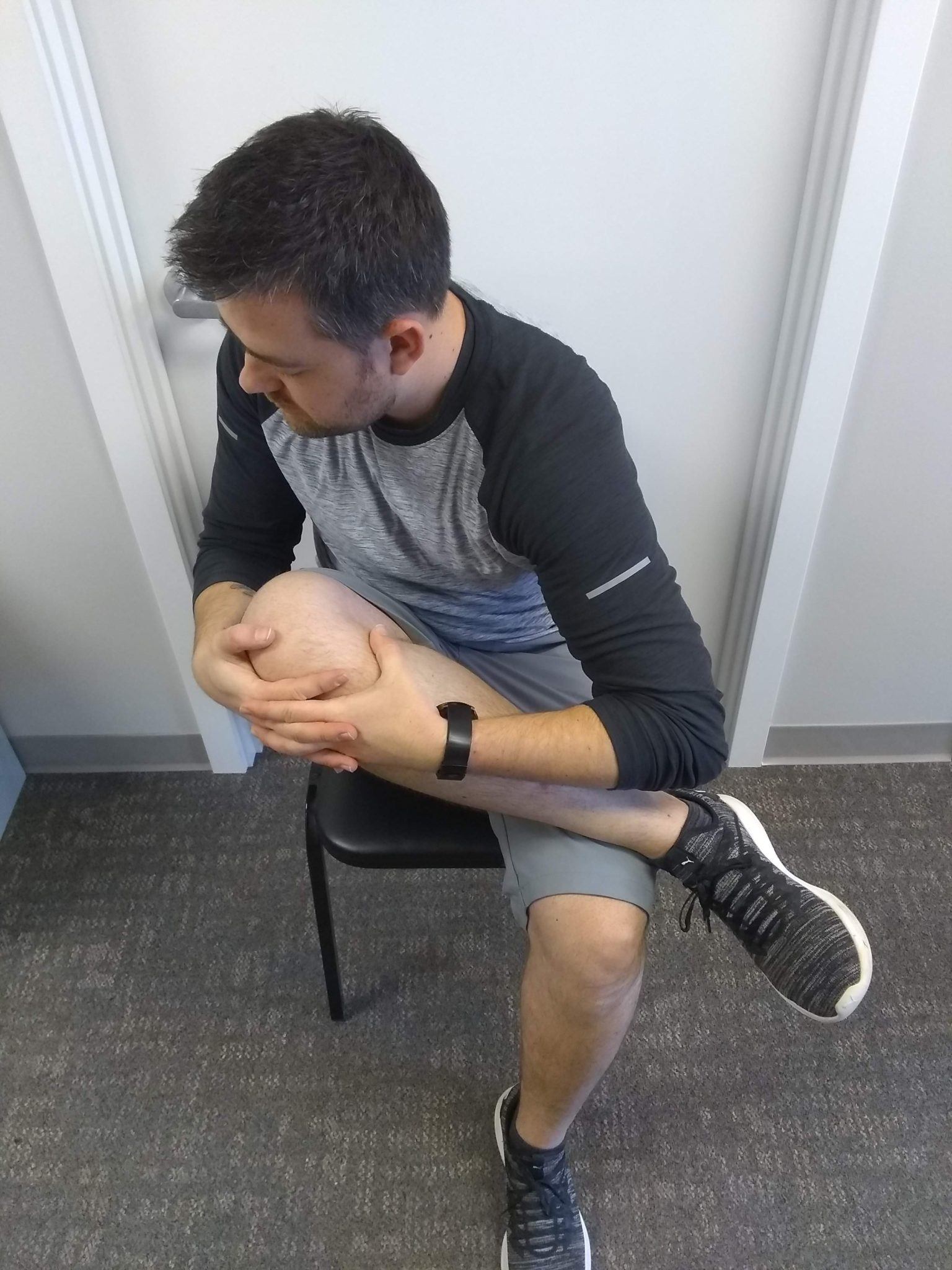
Ending Position for Piriformis Stretch
Exercise Frequency
In general, stretches should be held for about 30-60 seconds and repeated three (3) times. This stretch should be done at least once per day, three (3) days per week however, it can be done multiple times throughout the day every day for faster results. The piriformis stretch can be done while lying in bed before going to sleep or before getting out of bed, at home, at work, anywhere else that you can sit. This stretch should be done to help ease sciatic and SI pain however, ideally, it should be done prior to having pain.
Leaking Urine
Leaking urine when laughing, sneezing, or coughing is a common occurrence for women after pregnancy. This is referred to as stress incontinence, meaning when stress is placed on the bladder the muscles of the pelvic floor are unable to match the pressure thus causing urine to leak to relieve pressure on the bladder. Much like diastasis recti, this condition is associated with muscles becoming overly stretched during pregnancy and deliver, and as a result, are weakened. The difference between the two conditions is, with stress incontinence the muscles that are weaken are the muscles of the pelvic floor. As with any other condition with weakened muscle, this condition can improve with strengthening exercises.
Kegel
Many women are familiar with Kegel exercises. This exercise strengthens muscles in the pelvic floor to help improve incontinence problems by controlling and preventing the release of urine when pressure is applied to the bladder.
To ensure you are activating the correct muscles, stop the flow of urine midstream. Only stop your flow long enough to ensure you’re activating the muscles correctly, as stopping the flow of urine can cause a urinary tract infection (UTI). Another cue to use is to think about drawing those muscles in and up. Once you have correctly identified how to activate the pelvic floor muscles, you can do Kegel exercise anywhere without anyone noticing. Your shouldn’t be holding your breath and you should have to strain.
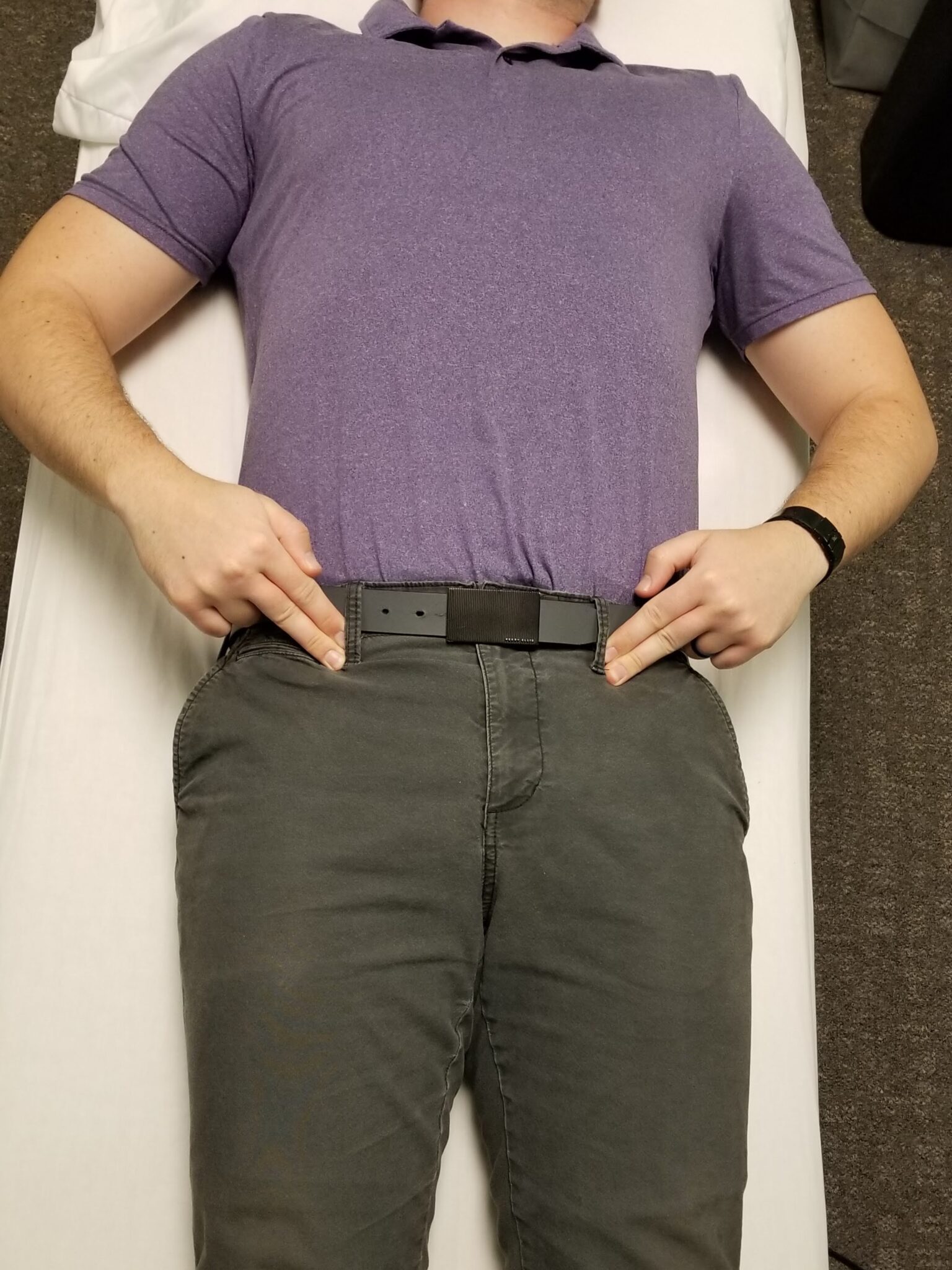
Kegel Check Hand Placement
Exercise Frequency
When first starting this exercise, you should hold this contraction for three (3) seconds ten (10) times and repeat that set three (3) times for a total of 30 holds with resting between sets. As these muscles get stronger, you can progress to holding the contraction for longer than three (3) seconds. This exercise should be done daily for the greatest benefits.
Depression
The World Health Organization reports there are 322 million people suffering from depression, world-wide, with more women being affected than men. Those numbers are just based on clinical depression. That’s not taking into account depression that may be associated with pregnancy when there’s all kinds of hormones. Postpartum depression is a serious condition.
The Mayo clinic list the following as symptoms of postpartum depression: depressed mood or severe mood swings, excessive crying, difficulty bonding with your baby, withdrawing from family and friends, loss of appetite or eating much more than usual, inability to sleep (insomnia) or sleeping too much, overwhelming fatigue or loss of energy, reduced interest and pleasure in activities you used to enjoy, intense irritability and anger, fear that you're not a good mother, hopelessness, feelings of worthlessness, shame, guilt or inadequacy, diminished ability to think clearly, concentrate or make decisions, restlessness, severe anxiety and panic attacks, thoughts of harming yourself or your baby, recurrent thoughts of death or suicide. After pregnancy, some women may have postpartum depression and some women may have depression that’s more rooted in their self-esteem due to all the physical changes that their bodies have gone through. No matter the reason for having depression, if you have any of these symptoms, talk to your doctor about treatments that include seeing a counselor or psychiatrist.
Aside from speaking with your doctor and psychiatrist, there are other methods you can use to help with depression. One method is the use of a seasonal light. I wrote another blog about this topic which you can read about by clicking here. The seasonal light targets seasonal depression however, the light can help improve your mood for anyone whether you have seasonal depression, postpartum depression, or just feeling down and need a “pick-me-up”. Another method to help depression is exercise. Regular exercise has been shown to improve depression symptoms. This improvement is partly due to a release of endorphins and other chemicals from our brains that naturally improves our mood. Exercising regularly may not resolve your depression but it is helpful, and it will improve your self-esteem.
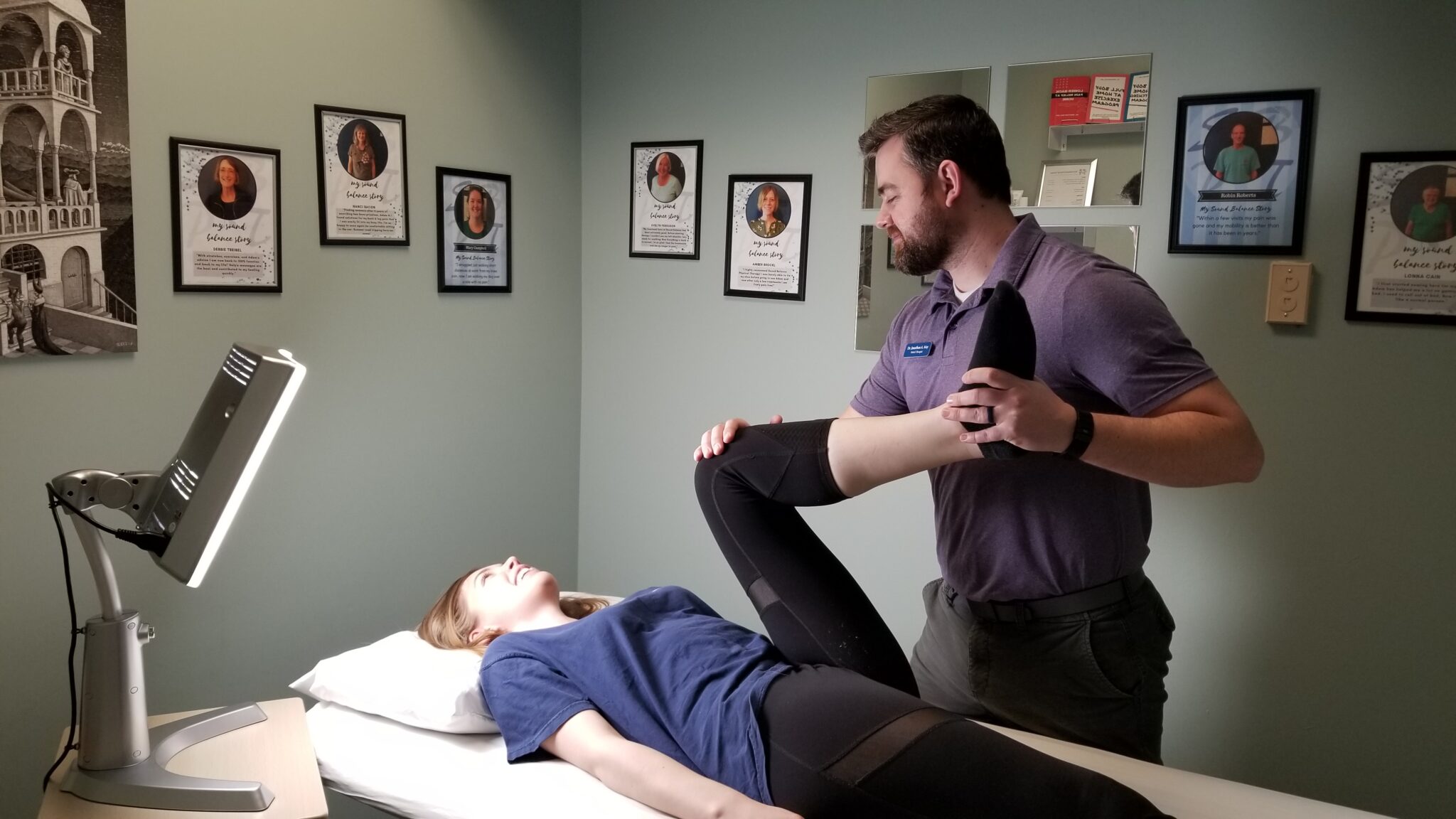
Stretch with Light Therapy
Conclusion
Many women experience conditions during pregnancy and postpartum that cause physical and emotional pain, discomfort and weakness. These conditions are typically easily treated with physical therapy however, it is uncommon for women to participate in physical therapy during or after their pregnancies. Five of the main conditions are addressed to assist postpartum recovery. The exercises addressed here can and should be done during pregnancy as well as postpartum to decrease pain and improve strength, function, and self-esteem of mothers.
Additional Resources
Visit our books page to get more information about stretching, exercise, and wellness. We also have a YouTube channel with video examples and descriptions for these exercises and more.


